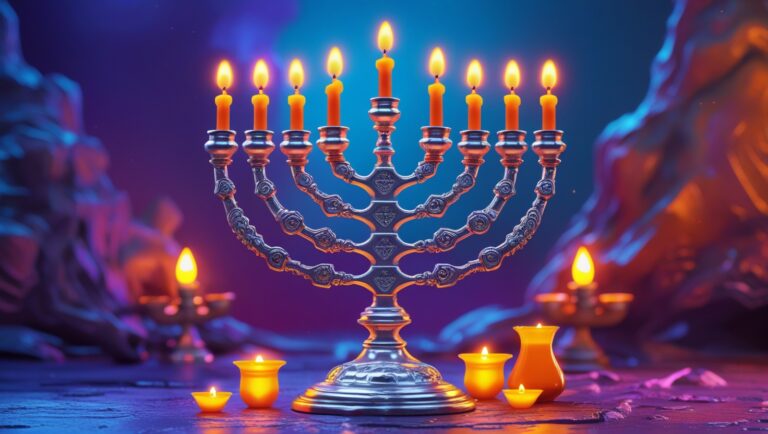Key ideas in Kabbalah from the Teachings of the Holy Rabbi Moshe Chaim Luzzatto (Ramchal)
It isn’t easy to summarize the greatness of the Ramchal in a single post but we can try. Rabbi Moshe Chaim Luzzatto (1707-1746), was a prominent Italian Jewish rabbi, philosopher, and mekubal. He is best known for his works on Jewish ethics and Kabbalah, among them the “Mesillat Yesharim” (Path of the Just) and “Derech Hashem” (The Way of God), and his tremendous devekut to Hashem.
One of his major allegorical works was “Migdal ‘Oz” (or “Tummat Yesharim”), written to celebrate the marriage of his friend Israel Benjamin Bassani. This four-act play is notable for its masterful versification and melodious language, rich with imagery reminiscent of classical poetry. The play illustrates the victory of justice over iniquity, an underlying theme in much of the Ramchal’s work.
In his later years in Amsterdam, the Ramchal was able to continue his Kabbalistic studies and writing with less hindrance. During this period, he wrote “Mesilat Yesharim” (1740), an ethical treatise with mystical underpinnings, and “Derekh Hashem” (The Way of God), a concise work on the core theology of Judaism which everyone knows about.
A significant turning point in his life came when he claimed to have received direct instruction from an angel (a “maggid”). When a person becomes incredibly pure and with constant devekut with Hashem, then it could be that his energy rises to a certain point where he develops spiritual eyes and can see beyond the physical world. Some say the Ramchal would walk with eyes almost completely closed all the time, which makes perfect sense.
This claim of receiving Torah from the angel, though fascinating to people, aroused suspicion among leading Italian rabbinical authorities, especially in the wake of the controversial messianic claims of Sabbatai Zevi. The “natural” reaction of those who don’t know anything about Kabbalah is to obviously persecute those whose Avodat Hashem they don’t understand.
The Ramchal’s writings during this period, some of which have been lost, were seen by some as heretical, and he faced severe opposition, including threats of excommunication.
We can find some of his works here on Sefaria. They are mostly in Hebrew though.
The Kabbalah of the Ramchal
His Kabbalistic writings, though less widely known than his ethical works, offer a comprehensive system for understanding the structure of Creation, and the nature of the divine emanations which we call Sephirot. These texts, including “Klach Pitchei Chokhmah” (138 Openings of Wisdom), provide a detailed and systematic exploration of Kabbalah and metaphysics, and Hashem’s involvement in Creation, aiming to harmonize the mystical tradition with rational thought and ethical living.
The breadth of the Ramchal’s scholarship—from mysticism and philosophy to ethics and drama—underscores his multifaceted genius and his enduring appeal. His ability to navigate diverse genres and disciplines, all while seeking to elevate the spiritual and moral condition of his contemporaries, makes his work as relevant today as it was in the 18th century.
Another significant work from this period is “Da’at Tevunot” (“The Knowing Heart”), which bridges rationality and Kabbalah. His writings received high praise from notable contemporaries, including the Vilna Gaon, who expressed deep admiration for “Mesilat Yesharim.” Despite the controversies surrounding him, the Ramchal’s works continued to influence Jewish thought long after his death and to this day. Literally every single Yeshiva and Beit Midrash has them.
Here, we explore some of the key Kabbalistic concepts central to the Ramchal’s teachings:
1. Sefirot and the Divine Structure
- Sefirot: Ramchal focused on the concept of Sefirot, which are the ten emanations through which the Infinite (Ein Sof) reveals Himself and continuously creates both the physical and spiritual realms. The Ramchal emphasized understanding the dynamic interplay between these Sefirot as a way to comprehend the divine flow of energy and consciousness.
- Divine Emanation: He taught that the Sefirot are not independent entities but manifestations of Hashem’s attributes, such as wisdom, understanding, and mercy. This approach helps bridge the transcendent “nature” of God with the immanent spiritual and physical worlds.
- Tzimtzum (Contraction): He also delved into the idea of Tzimtzum, the self-limitation of Divine light, which allows for the existence of an apparently independent reality outside of the Divine essence.
2. The Purpose of Creation and Human Role
- Free Will and Tikkun Olam (Repairing the World): Central to Ramchal’s teaching is the purpose of creation, which he saw as the ultimate expression of divine benevolence. He emphasized the role of human beings, endowed with free will, in the process of Tikkun Olam – the restoration or correction of the world, bringing it closer to a perfected state.
- Spiritual Ascent: The Ramchal described life as a journey of spiritual ascent, where individuals, through ethical living and spiritual practice, climb the “ladder” of divine emanations to get closer to Hashem.
- Messianic Era: Ramchal’s works often touch upon the end of days and the coming of the Messiah. He described the Messianic era as a time of universal enlightenment, where the presence of God will be fully revealed and known.
3. Personal Transformation
- Ethical Living: Unlike some Kabbalists who focused purely on the mystical, Ramchal emphasized the importance of ethical conduct and personal spiritual growth, viewing them as integral to the mystical journey.
- Integration of Mysticism and Halacha (Jewish law): He advocated for a synthesis between mysticism and practical Jewish law, arguing that true spiritual understanding is reflected in daily religious observance.
The Magnum Opus Mesilat Yesharim
“Mesilat Yesharim” (The Path of the Just) is a seminal work of Jewish ethical literature written by Rabbi Moshe Chaim Luzzatto, also known as the Ramchal. This work is considered a masterpiece in Jewish moral philosophy and is often studied in various Jewish learning contexts.
Here is a summary of its key themes and structure:
Overview
- Purpose: The book is designed as a guide to help people reach spiritual perfection, focusing on the development of personal traits and ethical conduct to reach true holiness.
- Structure: “Mesilat Yesharim” is structured as a step-by-step guide, progressing through various levels of spiritual and ethical development.
Key Themes from Mesilat Yesharim:
- “Man’s Duty in the World”: The opening chapter discusses the purpose of life and the importance of serving God with joy and enthusiasm.
- “Watchfulness”: This section emphasizes the need for self-awareness in one’s actions and thoughts, advocating for constant vigilance over one’s behavior.
- “Zeal”: Ramchal discusses the importance of enthusiasm and promptness in performing good deeds and following religious commandments.
- “Cleanliness”: This stage is about avoiding sin and moral impurity, focusing on purifying one’s actions.
- “Separation”: The focus here is on distancing oneself from unnecessary indulgences and material pleasures to achieve spiritual goals.
- “Purity”: This level deals with purifying one’s intentions, ensuring that actions are motivated purely by the desire to serve God.
- “Piety”: Piety is described as going beyond the letter of the law in one’s devotion to God and religious practice.
- “Humility”: Humility involves recognizing one’s own insignificance in comparison to God and avoiding arrogance.
- “Fear of Sin”: This stage emphasizes the importance of being cautious to avoid transgression and understanding the consequences of sin.
- “Holiness”: The final stage is about achieving a high level of sanctity and closeness to Hashem, marked by a profound spiritual connection and overall transformation of one’s psyche.
Conclusion
The Ramchal, Rabbi Moshe Chaim Luzzatto, holds a unique spot in Jewish history, blending the spiritual with the practical. His life and work shine as a guide for those seeking both wisdom and ethical living, proving resilient through controversy and time. His writings and chiddushim into achieving a balanced and meaningful life, have grown more popular over time, showing how enduring and impactful his ideas are.
Despite facing significant challenges, the Ramchal’s teachings have not only survived; they’ve thrived, demonstrating the strength and appeal of his approach to life and spirituality. This is how you recognize a real Tzadik: his influence only grows after his passing.
As we deal with the complexities of today’s world, the Ramchal’s words offer guidance that goes beyond the confines of Jewish tradition, speaking to anyone interested in living a life filled with purpose, integrity, and a deeper connection to what’s beyond us.
I venture to say that his writings are now more important than ever. May his merit protect us and his memory be for a blessing.







